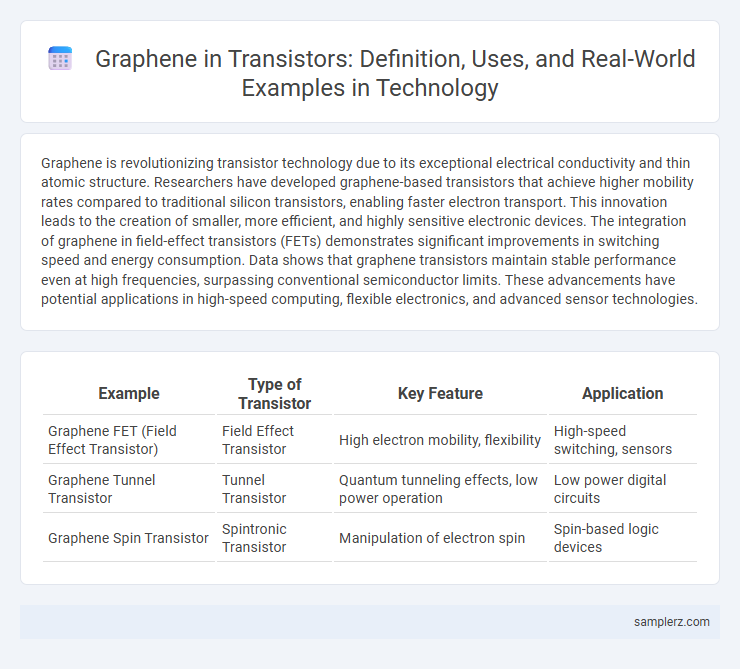Graphene is revolutionizing transistor technology due to its exceptional electrical conductivity and thin atomic structure. Researchers have developed graphene-based transistors that achieve higher mobility rates compared to traditional silicon transistors, enabling faster electron transport. This innovation leads to the creation of smaller, more efficient, and highly sensitive electronic devices. The integration of graphene in field-effect transistors (FETs) demonstrates significant improvements in switching speed and energy consumption. Data shows that graphene transistors maintain stable performance even at high frequencies, surpassing conventional semiconductor limits. These advancements have potential applications in high-speed computing, flexible electronics, and advanced sensor technologies.
Table of Comparison
| Example | Type of Transistor | Key Feature | Application |
|---|---|---|---|
| Graphene FET (Field Effect Transistor) | Field Effect Transistor | High electron mobility, flexibility | High-speed switching, sensors |
| Graphene Tunnel Transistor | Tunnel Transistor | Quantum tunneling effects, low power operation | Low power digital circuits |
| Graphene Spin Transistor | Spintronic Transistor | Manipulation of electron spin | Spin-based logic devices |
Introduction to Graphene-Based Transistors
Graphene-based transistors leverage the exceptional electrical conductivity and high carrier mobility of graphene, enabling faster switching speeds compared to silicon-based devices. The unique two-dimensional structure of graphene allows for effective electron transport, leading to potential applications in high-frequency and flexible electronics. Advances in fabrication techniques have facilitated the integration of graphene transistors into nanoscale circuits, promising significant improvements in performance and energy efficiency.
Advantages of Graphene in Transistor Design
Graphene's exceptional electron mobility significantly enhances transistor switching speeds, surpassing traditional silicon-based designs. Its atomic thickness allows for ultra-scaled transistors with reduced short-channel effects, improving energy efficiency and device miniaturization. Moreover, graphene's high thermal conductivity aids in effective heat dissipation, ensuring reliability and longevity in high-performance transistor applications.
Graphene Field-Effect Transistors (GFETs) Explained
Graphene Field-Effect Transistors (GFETs) utilize a single layer of carbon atoms arranged in a hexagonal lattice to enable exceptional electron mobility and conductivity, significantly outperforming traditional silicon-based transistors in speed and energy efficiency. The unique two-dimensional structure of graphene allows GFETs to operate at higher frequencies with low power consumption, making them ideal for next-generation high-speed electronic devices and flexible sensors. Recent advancements in fabricating stable graphene channels and optimizing gate dielectrics have accelerated the integration of GFETs into commercial semiconductor applications.
Key Research: Early Demonstrations of Graphene Transistors
Graphene transistors showcased remarkable electron mobility surpassing traditional silicon devices, enabling faster switching speeds and lower power consumption. Early experiments by researchers at IBM and University of Manchester demonstrated graphene's exceptional conductivity and potential as a channel material in field-effect transistors. These foundational studies established graphene's viability for ultra-high-frequency electronics and flexible, transparent devices in next-generation technology.
Graphene Transistors in Flexible Electronics
Graphene transistors exhibit exceptional electrical conductivity and mechanical flexibility, making them ideal for flexible electronics applications. Their ultrathin structure allows for the development of bendable, lightweight devices with enhanced performance and durability compared to traditional silicon-based transistors. This enables innovations in wearable technology, flexible displays, and foldable smartphones.
High-Frequency Performance of Graphene Transistors
Graphene transistors exhibit exceptional high-frequency performance due to graphene's ultrafast electron mobility exceeding 200,000 cm2/V*s, enabling operation in the terahertz range. Experimental devices demonstrate cut-off frequencies (fT) surpassing 300 GHz, significantly outperforming traditional silicon-based transistors. This high-speed capability positions graphene transistors as promising components for next-generation wireless communication and high-frequency signal processing applications.
Integration of Graphene with Silicon Technologies
The integration of graphene with silicon technologies enhances transistor performance by leveraging graphene's exceptional electrical conductivity and high carrier mobility. Graphene-based transistors exhibit faster switching speeds and lower power consumption compared to traditional silicon devices. This synergy enables the development of next-generation high-frequency and flexible electronic applications within existing semiconductor manufacturing frameworks.
Challenges in Commercial Graphene Transistor Production
Commercial graphene transistor production faces significant challenges, including the difficulty in achieving consistent large-area graphene synthesis with defect-free quality. Precise control over graphene layer thickness and uniform doping is crucial for reliable device performance but remains technologically complex. Scalability issues and integration with existing semiconductor processes further hinder widespread commercialization.
Real-World Applications of Graphene Transistors
Graphene transistors demonstrate exceptional electrical conductivity and flexibility, enabling faster and more efficient electronic devices. They are increasingly used in high-frequency communication systems, ultrafast processors, and wearable electronics due to their superior charge carrier mobility. Real-world applications also include improved sensors and flexible display technologies, which benefit from graphene's transparency and mechanical strength.
Future Prospects of Graphene in Next-Generation Electronics
Graphene's exceptional electron mobility and atomic-scale thickness make it a promising material for next-generation transistor technologies, enabling faster switching speeds and reduced power consumption compared to silicon-based devices. Researchers are developing graphene-based field-effect transistors (GFETs) that exhibit high-frequency performance suitable for advanced communication systems and flexible electronics. Continued advancements in scalable graphene synthesis and integration techniques pave the way for its widespread adoption in ultra-efficient, miniaturized electronic components.

example of graphene in transistor Infographic
 samplerz.com
samplerz.com